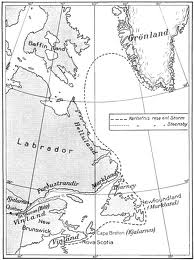Bishop Erik’s Unorthodox Trip, 1121 January 14, 2013
Author: Beach Combing | in : Medieval , trackbackLet’s start with historical orthodoxy. From c. 950-1000 Viking Greenlanders crossed the Davis Strait and set up a settlement or perhaps several small settlements in Canada. This settlement or these settlements may or may not have been just for the summer, but the fact is that, in any case, they were shortlived. The Greenlanders simply could not make it in the New World against the native Inuit (Markland) and, further to the south (Vinland), against Indians. The technological edge was too small – we are many centuries before Cortes – and the Greenlanders were always relatively few. From 1000 to the end of the Greenland settlement it is believed that there was little or no contact between the Greenland side of the Davis Strait and the Canadian side. Historians and archaeologists are usually pretty insistent on this, even to the point of demanding that New World boat timber in later Greenland had been washed up by the tides.
In fact, there are several pieces of evidence that suggest that the Greenlanders kept heading west and that are altogether difficult to explain. For example, in Gottskalk’s Annals (an Icelandic Chronicle) for 1121 we learn that ‘Erik the Greenland Bishop sought out Vinland’ ‘Eirik Graenlendingha byskup leitade Vinlands’. This is one of these entries that you read once, twice and then bang your head on the desk. If it is reliable – and there are problems about when Gottskalk’s Annals is properly contemporaneous and what were used as earlier sources – then we have a piece of evidence that sticks like a wriggling bumble bee in the ointment of orthodoxy.
Let’s count out the problems. (i) The reference is not just to Markland (Newfoundland) but Vinland, i.e. Nova Scotia or perhaps even Maine – WtH! (ii) This is not just a pirate mission or an attempt to get timber. The presence of a bishop surely suggests that there is a community involved or at least something more than an attempt to fell trees: though ‘sought out’ is rather strange. (iii) There is always the danger that annals from Scandinavian sources in the early period are just recounting the Sagas and may not be historical (in the strict sense of the word). But here we have again a bishop, not a family head or a warrior. At first, second and third glance it would be difficult to explain how this arrived in the annals from a fictional or from a semi-fictional source. (iv) This trip was unusual enough to get noticed, which begs the question whether it was remarkable because a bishop was involved or because Vinland was involved or because both were involved. Again we have ‘sought out’: had Vinland been lost?
The easiest explanation here is that the annal entry is corrupt. The second easiest explanation – it goes without saying that easiest explanations are not necessarily the correct ones – would be that Eirik was taking an unusual trip to a south to visit a small colony of Greenland Vikings in southern Canadian waters in the early twelfth century. At this point the ointment jar of orthodoxy has fallen on the bathroom floor and smashed into a thousand pieces. This is not a necessary deduction, of course. But these five words of Norse still make you think. Other explanations: drbeachcombing AT yahoo DOT com
***
3o April 2013: Jonathan from A Corner writes: ‘once again I emerge for my periodic canter through your fine blog, and run up against your post “Bishop Erik’s Unorthodox Trip, 1121”. I don’t know anything here but two things strike me as worth musing on; firstly, the text as quoted doesn’t say that Bishop Erik ever got there, which may be significant. But secondly, whether he did or no, I don’t see that it must imply that there were settlers there to whom he intended ministry. Might it is not in fact have been an (abortive) mission attempt to the locals whose presence he would, presumably, either have heard of or inferred? That wouldn’t damage orthodoxy too much, but would put the poor bishop in the list of those who sailed west without getting there perhaps. Does he ever attest again after this… ?’ What struck me [Beach] in reading through the literature is that there has never been a proper attempt to ground the Icelandic annals and until that is done and this annal is properly situated it is going to be an ungrounded exercise (to say the least). I was particularly anxious comparing Bishop Erik with the conventional list of Greenland bishops: and no he is not attested again (or before…). I wonder if we even have a legendary annal such as those that crop up in the Spanish, Irish and Welsh traditions. As to him not coming back this suggestion has often been made and too the idea that he converted the ‘gentiles’: the Vinland map forgery enjoys this. Thanks J!



